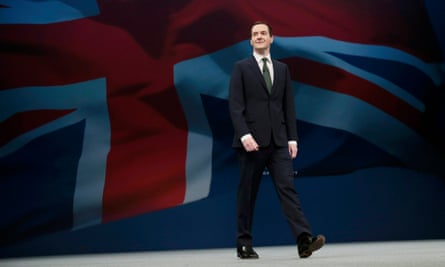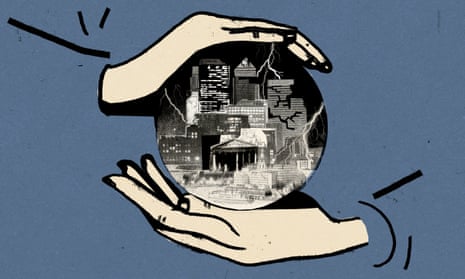October 2017: just hours to go, and still the words wouldn’t come. Other conference speeches had been straightforward. A few easy gags about the Labour leader, some gravelly bits about tough choices and the long-term economic plan and then – whoosh! – a rush of confident promises to zap the deficit and win the global race. The hall’s menagerie of blue-rinses and sixth-formers in suits got the message: George Osborne – a man you can trust with your finances, even if not love with all your heart. But now what was he going to say?
The chancellor glanced down at the A4 leaves, crawling with scribbles from his speechwriter and aides, and sighed. How different things had seemed just two years ago. Tory conference, autumn 2015: an election won, an economy humming, and him credited as the genius behind it all. Lobby hacks said he was the next prime minister. Lefty flacks thought he was parking tanks all over their parched little lawn. Westminster feared him; Beijing respected him. The world had hit Peak Osborne.
Just then, when his stock had never been higher, things began to go wrong: indicators across the economic dashboard started to flash red. Oil prices kept falling, which he could live with as at least it shut the motorists up. But it wasn’t just crude that was dropping, it was steel, nickel, zinc. Copper prices plunged to their lowest point since the banking meltdown. That really sent Treasury staff reeling: every mandarin knew that where copper went, the world economy tended to follow.
Osborne mentally replayed the movie of those few weeks. Even by the tail-end of September, little of this was in front of the public. On Fleet Street, the City desks of the newspapers were getting jittery, while most of their colleagues went down to Brighton to poke fun at Jeremy Corbyn. But the week of Labour’s conference was also the week that the old British Steel plant on Teesside – the second largest in Europe – got mothballed, leaving thousands out of a job.
OK, so that was the north-east, and which self-respecting Tory even knew where that was? But then there was Glencore, once the 10th biggest company on the planet. About 70% had been wiped off the value of the mining group in just a few months. By the end of September it was fighting for its life. Osborne remembered the Monday one young adviser had run into his office with news that Glencore boss Ivan Glasenberg had lost $500m of his personal fortune – in just one day’s trading. That same day he heard the fateful phrase that would keep popping up over the next few months, “another Lehman moment”.
Already that autumn the World Bank was panicking. The OECD was beside itself. Over at the International Monetary Fund, Osborne’s old mate Christine Lagarde was warning that the global economy was heading into “the new mediocre”.
What was happening was simple. After the catastrophes of 2008-09, exhausted western leaders had relied on Asia and eastern Europe to pick up the baton and front-run the world economy. Financiers on Wall Street and Canary Wharf had gone pell-mell into these emerging markets, bearing billions in easy credit. Since 2010, the emerging markets had accounted for 80% of global growth, half of that coming from China alone. Now, after five boom years, the bubble was finally bursting and the fate of the world rested squarely in the hands of unelected technocrats, whether in Beijing or in central banks in Threadneedle Street, Frankfurt or Washington.
Despite its avowals, China’s communist leadership just couldn’t work the same magic. In mid-October, when the politburo met to discuss the 13th five-year plan, its forecasts of 8% GDP growth were met with a sound never before heard from the economic policy-making community: the sniggering of deep scepticism.
Britain was being sucked into what Andy Haldane, chief economist at the Bank of England, called “the emerging markets crisis of 2015”. In a speech in late September he’d described how, in less than a decade, the world had lurched from crash to crash to crash: first in the US and UK, then Europe, and now Asia and other developing regions.

Once, what happened in Shanghai would have made little odds in the retail parks of Sheffield. But the post-crash world economy was much more tightly bound together. As Haldane pointed out, British-owned banks’ exposure to greater China alone was worth $540bn.
Soon, top-end bankers and property developers were murmuring in the chancellor’s ear about how Russian oligarchs, whose fortunes had been underpinned by high commodity prices, were now liquidating their portfolios. It wasn’t just stakes in British businesses that were being slung on to the market; handfuls of luxury homes in Kensington were suddenly up for sale.
Just across Whitehall, Sajid Javid had nearly had his door knocked down by antsy vice-chancellors from half the Russell Group universities, fretting about huge drops in their lucrative foreign students – and massive holes in their balance sheets.
For years, world leaders had relied on cheap credit to fuel growth in the west and then the east. The credit was still flowing, but the growth had slowed to a mere trickle. Osborne had tried something similar at home. His first two years in No 11 were full of promises of more exports and business investments. When by 2012 those unicorns hadn’t turned up and David Cameron was in meltdown, Osborne’s team resorted instead to pumping up the credit bubble. That meant shovelling money into the housing market. It also meant relying on the Bank of England to keep interest rates on the floor.
All that brought was the weakest recovery in the history of British capitalism – one that was also reliant on precarious loans rather than wages. Nearly 80% of car sales were made using showroom finance deals, up from around 50% in 2008; the massive spike in the buy-to-let market was reliant on interest-only mortgages.
After Iceland’s collapse, London had been dubbed Reykjavik-on-Thames for its dangerous reliance on lunatic house prices, massive credit and a huge finance sector. As this latest downturn deepened into 2016, it became clear how little Osborne had changed that. And unlike Alistair Darling in 2008 he had next to no ammo. The Labour government could at least run up a budget deficit, and count on Mervyn King to slash interest rates. With base rates at 0.5%, King’s successor, Mark Carney, had no such wiggle room – while his austerity chancellor was too slow to pump up spending as his public finance targets were blow away.
Osborne looked up towards windows letting in the watery morning light. Soon he’d have to put the best gloss possible on all of this to conference. But who was that on the radio? Oh yes, his opposite number John McDonnell. What was he saying? “This chancellor didn’t fix the roof while the sun was shining.”

